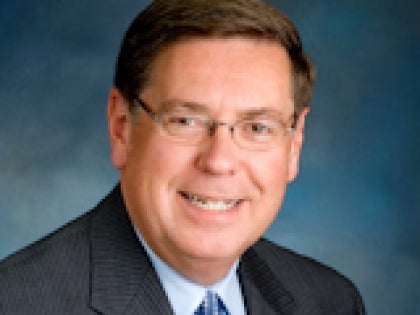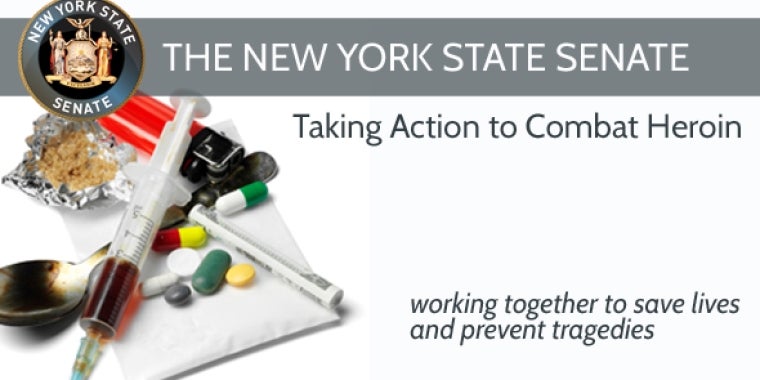
Seward Bill Key Part Of Senate Heroin Package
James L. Seward
June 9, 2014
-
ISSUE:
- Health
- Insurance
- Controlled Substances

ALBANY, 06/09/14 -- State Senator James L. Seward (R/C/I – Oneonta) today announced senate passage of a package of legislation to fight the growing heroin and opioid abuse epidemic. A bill sponsored by Senator Seward (S.7662) that would improve access to insurance coverage for substance abuse treatment and dependency services was part of the package.
“These measures will save lives – plain and simple,” said Senator Seward. “My bill in particular, improving access to insurance coverage, will help provide the medical care needed to aid in breaking the stranglehold heroin and other opioids have on far too many addicted individuals.”
Senator Seward was appointed to the New York State Senate Joint Task Force on Heroin and Opioid Addiction in March and hosted a task force forum in Oneonta to solicit input from local health care professionals, addiction experts, law enforcement officials, and concerned citizens. In all, 18 forums were held across the state.
“The bills approved by the senate address real needs articulated to the task force by experts on the front lines and individuals who battle their own addiction demons. Devastating testimony at the forum I hosted from those who know firsthand the toll addiction can take, including a mother who lost her son to an addition related suicide, clearly illustrated the need for swift action,” Seward added.
Senate bill 7662 requires health plans to use a medical director who specializes in substance abuse when making coverage decisions, standardizes the criteria used to make coverage determinations, and creates a workgroup to study and make recommendations on improving access to treatment services. The bill also creates an expedited appeal process for individuals when services are denied, and requires that health plans pay for treatment while a denial is being appealed.
In all, the senate approved 23 bills designed to prevent drug abuse and overdoses, increase the availability and efficacy of addiction treatment, and enhance the tools provided to law enforcement to keep heroin off the streets.
“No one is immune to the damages of heroin. The epidemic is infiltrating all social, economic, and geographic sectors of our state and taking a deadly toll. We now have a multi-prong strategy to combat this epidemic that includes education and prevention, treatement, and tougher law enforcement measures. I am hopeful the assembly will join the senate and approve these bills before the end of the legislative session so they can be sent to the governor for his consideration, lives truly depend on it,” Seward concluded.
-30-
The task force bills approved by the senate include:
Preventing Opioid Abuse and Overdoses
• Preventing opioid overdoses in schools (S7661, Hannon): Clarifies that school districts, Board of Cooperative Educational Services (BOCES) programs, charter schools, and other educational entities may possess and administer naloxone to treat opioid overdoses, and will be protected by Good Samaritan laws.
• Increasing the effectiveness of overdose prevention (S7649A, Marchione): Provides that naloxone kits distributed through an opioid overdose prevention program must include an informational card with instructions on steps to take following administration, as well as information on how to access addiction treatment and support services. Opioid overdose prevention programs provide those at risk of an overdose, their family members and their friends with naloxone kits and training on proper administration.
• Limiting prescriptions for acute pain (S2949A, Hannon): Limits the number of Schedule II and III controlled substances prescribed for acute pain to a 10-day supply to prevent excess pharmaceuticals from being dispensed, and therefore reduce the risk of diversion. This restriction would not apply to the treatment of cancer pain, chronic pain or palliative care. Further, the bill provides that only one co-payment may be charged for a 30-day supply.
• Increasing public awareness (S7654, Boyle): Requires the Office of Alcoholism and Substance Abuse Services (OASAS) and the Department of Health (DOH) to establish the Heroin and Prescription Opioid Pain Medication Addiction Awareness and Education Program. The program would utilize social and mass media to reduce the stigma associated with drug addiction, while increasing public’s knowledge about the dangers of opioid and heroin abuse, the signs of addiction, and relevant programs and resources.
• Establishing school drug prevention programs (S7653, Martins): Adds age-appropriate information about the dangers of illegal drug use to junior high school and high school health class curriculums.
• Promoting pharmaceutical take-back events (S6691, Boyle): Requires OASAS to post guidelines and requirements for conducting a pharmaceutical collection event on its website. According to the Substance Abuse and Mental Health Service Administration (SAMHSA), nearly 70 percent of those who first abuse prescription drugs get the pills from a friend or relative. Facilitating proper and timely disposal of unused narcotics helps to reduce the danger of diversion.
• Ensuring prescribing practitioners stay abreast of best practices (S7660, Hannon and Maziarz): Creates a continuing medical education program for practitioners with prescribing privileges. DOH and the State Education Department (SED) would establish standards for three hours of biennial instruction on topics including Internet System for Tracking Over-Prescribing (I-STOP) requirements, pain management, appropriate prescribing, acute pain management, palliative medicine, addiction screening and treatment, and end-of-life care.
Increasing the Availability and Efficacy of Addiction Treatment
• Creating a new model of detoxification and transitional services (S2948, Hannon): Establishes the Opioid Treatment and Hospital Diversion Demonstration Program, requiring the development of a new model of detoxification and transitional services for individuals seeking to recover from opioid addiction that reduces reliance on emergency room services.
• Establishing a relapse prevention demonstration program (S7650, Carlucci): Creates a Wraparound Services Demonstration Program through which OASAS would provide case management or referral services for nine months to individuals who successfully complete substance abuse treatment programs. These community supports - access to which is intended to prevent a relapse - include educational resources, peer-to-peer support groups, social services and family services and counseling, employment support and counseling transportation assistance, medical services, legal services, financial services, and child care services.
• Enabling parents to require children to undergo treatment (S7652A, Martins): Provides that a parent or guardian may petition to have a minor child designated as a Person in Need of Supervision (PINS) due to a substance use disorder, and that a court may require a PINS child to undergo substance abuse treatment.
• Establishing assisted outpatient treatment for substance use disorders (S7651A, Carlucci): Enables a court to order Assisted Outpatient Treatment (AOT) for an individual with a substance use disorder who, due to his or her addiction, poses a threat to him or herself or others.
• Promoting the affordability of substance abuse services (S7662A, Seward, Hannon, Martins and Ritchie): Improves the utilization review process for determining insurance coverage for substance abuse treatment disorders, and requires insurers to continue to provide coverage throughout the appeals process.
Providing Additional Resources to Law Enforcement
• Studying the conversion of correctional facilities to treatment centers (S7655A, Boyle and Nozzolio): Directs OASAS and the Department of Corrections and Community Supervision (DOCCS) to study the feasibility of converting closed correctional facilities to provide treatment for substance use disorders. Agencies would examine the feasibility of such centers providing both inpatient residential and outpatient care.
• Establishing the crime of homicide by sale of an opioid controlled substance (S7657, Robach): Creates an A-I felony for the unlawful transportation or sale of an opioid that causes the death of another.
• Restricting drug dealers from participating in the SHOCK incarceration program (S7656, Nozzolio): Holds drug dealers accountable by preventing participation in the SHOCK incarceration program – under which young adults receive substance abuse treatment, academic education, and other services to promote reintegration – by individuals convicted of a A-II felony drug offense, except if he or she tests positive for a controlled substance upon arraignment.
• Creating Drug-Free Zones around treatment facilities (S1388, Skelos): Establishes a B felony for the sale of a controlled substance within 1,000 feet of a drug or alcohol treatment center or methadone clinic.
• Improving safety at judicial diversion programs (S1879A, Bonacic): Requires a court, in determining a defendant's eligibility for a judicial diversion program for alcohol or substance abuse treatment, to consider the underlying charges and the defendant's propensity for violent conduct. The bill also requires the facility treating a defendant under this diversion program to notify the local law enforcement of the defendant's placement and arrest record, and to submit a security plan to the Division of Criminal Justice Services (DCJS) to provide for the safety of staff, residents and the community. Finally, this bill allows a defendant to appear via video conference, and makes unauthorized departure from a rehabilitation facility a D felony.
• Reallocating funds from asset forfeitures (S7658, Nozzolio): Reduces the state share of certain asset forfeitures to increase allocations for the reimbursement of expenses incurred by localities for investigation and prosecution, and provides additional monies for the Chemical Dependence Service Fund.
• Expanding the crime of operating as a major trafficker (S7663, Nozzolio): Facilitates convictions for operating as a major trafficker by reducing the number of people that must have participated from four to three, and lowering the minimum required proceeds from the sale of controlled substances during a 12-month period from $75,000 to $25,000.
• Establishing the crime of transporting an opioid controlled substance (S7659, Boyle): Allows prosecution for a new crime when an individual unlawfully transports an opioid any distance greater than five miles within the state, or from one county to another county within the state, to address diversion and distribution of heroin and prescription drugs.
• Facilitating the conviction of drug dealers (S7169, Boyle): Provides that possession of 50 or more packages of a Schedule I opium derivative, or possession of $300 or more worth of such drugs, is presumptive evidence of a person’s intent to sell.
• Establishing criminal penalties for the theft of blank official New York State prescription forms (S2940, Hannon): Expands grand larceny in the fourth degree to include the theft of a blank official New York State prescription form. This bill would also redefine criminal possession of stolen property in the fourth degree to include the possession of a stolen New York State prescription form, and create an A misdemeanor of criminal possession of a prescription form.
• Prosecuting acts by street gangs (S4444A, Golden): Creates the Criminal Street Gang Enforcement and Prevention Act to provide a comprehensive approach to protecting the public from gang-related crimes and violence, including those that relate to drug trafficking, and establishing the criminal street gang prevention fund.
Share this Article or Press Release
Newsroom
Go to NewsroomSeward, Senate Republicans Unveil Victims' Justice Agenda
April 30, 2019

State Budget Fails New Yorkers
March 31, 2019


